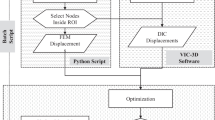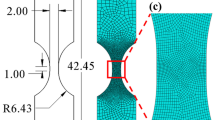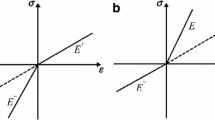Abstract
Background
Digital Image Correlation (DIC) is an advanced measurement technique capable of capturing full-field surface displacements in a non-invasive manner. However, the application of such measurements in the identification of bimodular materials remains insufficiently exploited.
Objective
Recalibration with Analytic Solution Updating (RAU) has been proposed for the identification of mechanical elastic parameters of asymmetric constitutive law behavior using the Brazilian test. This method accomplishes identification by minimizing the gap between the measurements and the semi-closed form solution.
Methods
Two types of data are employed: the first derived from the semi-closed form solution and the second measured on a 42-day aged mortar specimen using DIC. In the RAU method, three distinct cases are implemented to identify mechanical elastic parameters. These cases are determined by the nature of the data utilized, which can be categorized into axial displacement field, strains at the center, and full-field surface displacement measured on a given specimen area.
Results
The RAU method successfully identified the compressive, tensile Young’s modulus, and the compressive Poisson’s ratio from the surface data provided. The identification with full-field surface displacement presented the highest level of accuracy in the RAU method using the identified results of synthetic data.
Conclusion
The RAU method demonstrates significant accuracy and practicality in identifying the mechanical elastic parameters of bimodular materials.












Similar content being viewed by others
Data Availability
Data available on request from the authors.
References
ISRM (1978) Suggested methods for determining tensile strength of rock materials part 2: suggested method for determining indirect tensile strength by the Brazil test. Int J Rock Mech Min Sci 15:99–103
Li D, Wong LNY (2013) The Brazilian disc test for rock mechanics applications: review and new insights. Rock Mech Rock Eng 46:269–287. https://doi.org/10.1007/s00603-012-0257-7
García VJ, García VJ, Márquez CO, Zúñiga-Suárez AR, Zuñiga-Torres BC, Villalta-Granda LJ (2017) Brazilian test of concrete specimens subjected to different loading geometries: review and new insights. Int J Concr Struct Mater 11:343–363. https://doi.org/10.1007/s40069-017-0194-7
Kourkoulis SK, Markides CF, Chatzistergos P (2012) The Brazilian disc under parabolically varying load: theoretical and experimental study of the displacement field. Int J Solids Struct 49:959–972. https://doi.org/10.1016/j.ijsolstr.2011.12.013
Wang T, Ye J (2023) Numerical analysis of bending property of bi-modulus materials and a new method for measurement of tensile elastic modulus. J Rock Mech Geotech Eng. https://doi.org/10.1016/j.jrmge.2023.03.003
Patel S, Martin CD (2018) Evaluation of tensile young’s modulus and Poisson’s ratio of a bi-modular rock from the displacement measurements in a Brazilian test. Rock Mech Rock Eng 51:361–373. https://doi.org/10.1007/s00603-017-1345-5
Claesson B, Bohloli J (2002) Brazilian test: stress field and tensile strength of anisotropic rocks using an analytical solution. Int J Rock Mech Min Sci 39:991–1004. https://doi.org/10.1016/S1365-1609(02)00099-0
Huang T, Huang T, Pan QX, Jin J, Zheng J, Wen P (2019) Continuous constitutive model for bimodulus materials with meshless approach. Appl Math Model 66:41–58. https://doi.org/10.1016/j.apm.2018.09.004
Tsvelodub IY (2008) Multimodulus elasticity theory. J Appl Mech Tech Phys 49:129–135. https://doi.org/10.1007/s10808-008-0019-1
Latorre M, Montáns FJ (2020) Bi-modulus materials consistent with a stored energy function: Theory and numerical implementation. Comput Struct 229:106176. https://doi.org/10.1016/j.compstruc.2019.106176
Jianhong Y, Wu FQ, Sun JZ (2009) Estimation of the tensile elastic modulus using Brazilian disc by applying diametrically opposed concentrated loads. Int J Rock Mech Min Sci 46:568–576. https://doi.org/10.1016/j.ijrmms.2008.08.004
Wei J, Niu L, Song J-J, Xie L (2019) Estimation of rock tensile and compressive moduli with Brazilian disc test. Geomechanics and Engineering 19(4):353–360. https://doi.org/10.12989/gae.2019.19.4.353
Nsengiyumva G, Kim Y-R (2022) Field displacement-based inverse method for elastic and viscoelastic constitutive properties. Exp Mech 62:1553–1568. https://doi.org/10.1007/s11340-022-00876-0
Fayad S, Jones E, Seidl D, Reu P, Lambros J (2022) On the importance of direct-levelling for constitutive material model calibration using digital image correlation and finite element model updating. Exp Mech 63:467–484. https://doi.org/10.1007/s11340-022-00926-7
Padmanabhan S, Hubner JP, Kumar AV, Ifju P (2006) Load and boundary condition calibration using full-field strain measurement. Exp Mech 46:569–578. https://doi.org/10.1007/s11340-006-8708-2
Liu C (2010) Elastic constants determination and deformation observation using Brazilian disk geometry. Exp Mech 50:1025–1039. https://doi.org/10.1007/s11340-009-9281-2
Ye J, Wu F, Zhang Y, Ji HG (2012) Estimation of the bi-modulus of materials through deformation measurement in a Brazilian disk test. Int J Rock Mech Min Sci 52:122–131. https://doi.org/10.1016/j.ijrmms.2012.03.010
Hild F, Roux S (2005) Digital image correlation: from displacement measurement to identification of elastic properties. Strain 42:69–80
Avril S, Bonnet M, Bretelle AS, Grédiac M, Hild F, Ienny P, Latourte F, Lemosse D, Pagano S, Pagnacco E, Pierron F (2008) Overview of identification methods of mechanical parameters based on full-field measurements. Exp Mech 48:381–402. https://doi.org/10.1007/s11340-008-9148-y
Pierron F, Grédiac M (2020) Towards material testing 2.0. a review of test design for identification of constitutive parameters from full-field measurements. Strain. https://doi.org/10.1111/str.12370
Hung KM, Ma C-C (2003) Theoretical analysis and digital photoelastic measurement of circular disks subjected to partially distributed compressions. Exp Mech 43:216–224. https://doi.org/10.1007/bf02410502
Ma C-C, Hung K-M (2008) Exact full-field analysis of strain and displacement for circular disks subjected to partially distributed compressions. Int J Mech Sci 50:275–292. https://doi.org/10.1016/j.ijmecsci.2007.06.005
Li Y, Xie H (2022) Numerical and experimental studies on the heterogeneous mechanical characteristics of the laser repaired components 63:401–413. https://doi.org/10.1007/s11340-022-00922-x
Mei Y, Deng J, Deng J, Deng J, Guo X, Goenezen S, Avril S (2021) Introducing regularization into the virtual fields method (VFM) to identify nonhomogeneous elastic property distributions. Comput Mech 67:1581–1599. https://doi.org/10.1007/s00466-021-02007-3
Nguyen T, Huntley JM, Ashcroft IA, Ruiz PD, Pierron F (2014) A fourier-series-based virtual fields method for the identification of 2-D stiffness and traction distributions. Strain 50:454–468. https://doi.org/10.1111/str.12105
Hondros G (1959) The evaluation of Poisson’s ratio and the modulus of materials of a low tensile resistance by the Brazilian (indirect tensile) test with particular reference to concrete. Aust J Appl Sci 10:243–264
Rethore J (2018) UFreckles (v 2.0). Zenodo. https://doi.org/10.5281/zenodo.1433776
Conn AR, Gould NIM, Toint PL (2000) Trust region methods. Society for Industrial and Applied Mathematics, Philadelphia. https://doi.org/10.1137/1.9780898719857
Van Rossum G, Drake FL (2009) Python 3 reference manual. CreateSpace, Scotts Valley, CA
Han Y, Lai B, Liu H-H, Li H (2018) Measurement of elastic properties in Brazilian disc test: solution derivation and numerical verification. Geomechanics and Geophysics for Geo-Energy and Geo-Resources 4:63–77. https://doi.org/10.1007/s40948-017-0075-1
Funding
The authors gratefully acknowledge the financial support for the doctoral study of Hao Hong provided by the China Scholarship Council (CSC, no.202008070080), and the support of Région Auvergne-Rhône-Alpes-France provided through project RICO2C.
Author information
Authors and Affiliations
Corresponding authors
Ethics declarations
Conflict of Interest
The authors declare that they have no conflict of interest.
Additional information
Publisher's Note
Springer Nature remains neutral with regard to jurisdictional claims in published maps and institutional affiliations.
Rights and permissions
Springer Nature or its licensor (e.g. a society or other partner) holds exclusive rights to this article under a publishing agreement with the author(s) or other rightsholder(s); author self-archiving of the accepted manuscript version of this article is solely governed by the terms of such publishing agreement and applicable law.
About this article
Cite this article
Hong, H., Baranger, T. Identification of Bimodular Material Parameters via a Semi-Closed Form Solution of the Brazilian Test. Exp Mech (2024). https://doi.org/10.1007/s11340-024-01058-w
Received:
Accepted:
Published:
DOI: https://doi.org/10.1007/s11340-024-01058-w




